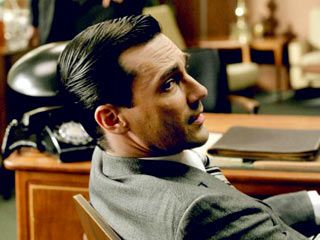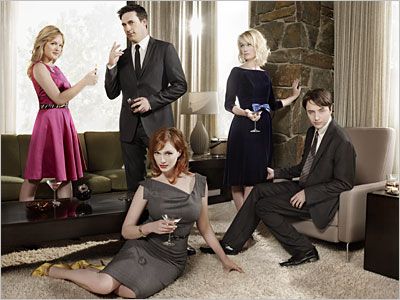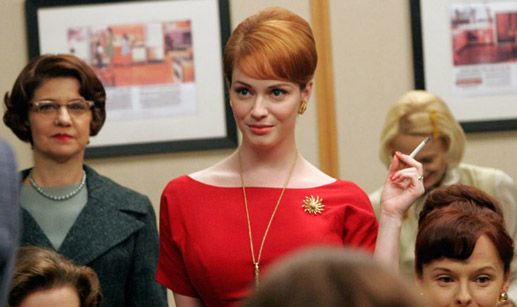Mad Men is all about veneer, the illusion of the perfect person and the perfect family in the early 1960's. Our hero Don Draper works at an ad agency, Sterling Cooper, and creates the illusion of the perfect life in print. Though Don and his wife Betty Draper are wealthy and attractive with a large home and two kids, there is a dark underbelly to their seemingly model life. Drinking and smoking are the norm for everyone, whether in the office or outside of it. Shockingly to contemporary audiences, Betty smokes and drinks while pregnant, the custom in those times. Like many early 1960's hard-nosed, keep your chin up type-people, Betty and Don Draper are appalling parents. Cold, uncommunicative and barely affectionate, they send their kids outside, upstairs or to watch television if the wind so much as blows. It's amazing that the Draper's little boy dosen't grow up to be Showtime's Dexter, the loveable sociopath serial killer. More after the jump:
It's great to see the entire cast from the first two seasons back again. Though Sterling Cooper is in the grip of a takeover by a British company and the screws are beginning to tighten around the agency's free spending, free-drinking ways, our favorite complicated schemers are still scrambling for wealth and position. One of my favorites, Roger Sterling plays much like Larry Tate from Bewitched, drifting around his agency in a self-satisfied haze. He drinks about as much as Larry Tate did, too, except Larry never divorced his wife. The fabulous Joan Holloway must stoically persevere as her ticket out of the office, her new doctor husband, disappoints her again and again. Finally, tenacious copywriter Peggy Olson tries to balance her newfound position in the company with her needs a woman.
Just as in past seasons, racism, sexism and prejudices against the overweight (and just about everybody else) are the norm, yet it's still startling to hear such ideas said out loud on the show, as if they were ordinary and acceptable. Society is beginning to change as the 60's advance in the Mad Men world, and it is fascinating to see our characters either begin the transition toward a progressive mentality, or blithely continue to cling to ignorant stereotypes. As Don Draper himself says, " Change isn't good or bad. It just is."
The bonus features on the Mad Men season three set are topical, but don't really address what viewers, or should I say this viewer wants: behind the scenes footage about the making of the show, and an examination of the beautiful costumes and sets. Understandably, the show is so particular and accurate about every little detail that creates this bygone era that a DVD extra like that might destroy the illusion. Still, "We Shall Overcome: The March on Washington" and "Medgar Evers: An Unsung Hero" are heavy subject matter for someone who just wants to look at pretty dresses. Perhaps I'm watching the wrong show for fluff like that. Another appropriate, interesting but intense documentary included in the bonus features is "Clearing the Air: The History of Cigarette Advertising," which is shown in two parts. This of course is appropriate because of the Sterling Cooper ad agency, which sells all sorts of questionable products like cigarettes using brilliant but devious psychological tactics. Art imitates life.
Another extra that is the most satisfying for fans of the show (and not so much the history of the era) are audio commentaries over each Mad Men episode of the season. Each episode features different visitors, including show writers and directors as well as actors from the show. Nearly every actor charmingly visits the commentaries except for January "Betty Draper" Jones, whose thoughts would have been interesting indeed. I mean, the frost emanating off of this fantastic actress is incredible in the series, not to mention in the photos inside of the DVD box! These excellent commentaries culminate with episode 13, called "Shut the Door, Have a Seat." This episode has an unexpectedly funny grouping of actors: Jon "Don Draper" Hamm, Robert "Bertram Cooper" Morse and John "Roger Sterling" Slattery, who are absolutely hysterical throughout the viewing. It was a great way to leave the show and actors for another season, on an "up" note.
Finally, the bonus feature "Mad Men Illustrated," is about the illustrator Dyna Moe (oooo-kaaaay...) and her creative and graphic Mad Men drawings, which are surprisingly accurate to the characters that they represent. One can even Mad Men themselves on the AMC website, based on the style of Moe's illustrations. Even with this last bit of whimsy, the fact that the sets and costumes remain unexplored is a bit annoying, but the quality and scandal-factor of the show far outweighs any niggling about the DVD extras that I might have. I look forward to season four with baited breath...and cigarettes and a stiff drink.





